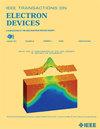Observation of Peltier Cooling and Great Potential of Electroluminescent Cooling in GaN-Based Light-Emitting Diodes
IF 3.2
2区 工程技术
Q2 ENGINEERING, ELECTRICAL & ELECTRONIC
引用次数: 0
Abstract
Light-emitting diodes (LEDs) are essential for future energy-saving lighting and display technology owing to their high efficiency, long lifetime, and low cost. To further enhance the performance of GaN-based LEDs, electroluminescent (EL) cooling has been widely predicted to be useful over the past several decades; however, it has not been experimentally achieved. Herein, thermoelectric and phonon-pumped GaN-based LEDs have been demonstrated by both experimental measurements and theoretical modeling. It is surprisingly found that the effect of increasing temperature changes from negative to positive when the operating point is moved to the high-efficiency, midvoltage range. The power efficiency exhibits a maximum 2.24-fold improvement with increasing temperature (from room temperature to 473 K), and the peak efficiency at all elevated temperatures outperforms that at room temperature, where the Peltier effect changes from Peltier heat to Peltier cooling. Under lower biases, the phonon-assisted Peltier cooling provides additional energy for carriers to overcome the potential barrier and achieve recombination. The findings not only give an insightful understanding of EL cooling but also provide guidelines on thermal management and designing high-performance GaN-based LED devices and arrays (e.g., micro-LEDs), which can be further extended to other kinds of LEDs and optoelectronic devices.氮化镓基发光二极管珀尔帖冷却和电致发光冷却潜力的观察
发光二极管(led)由于其高效率、长寿命和低成本,对未来的节能照明和显示技术至关重要。为了进一步提高氮化镓基led的性能,电致发光(EL)冷却在过去的几十年里被广泛预测是有用的;然而,它还没有在实验中实现。本文通过实验测量和理论建模证明了热电和声子泵浦gan基led。令人惊讶的是,当工作点移动到高效率、中压范围时,温度升高的影响由负变为正。随着温度的升高(从室温到473 K),功率效率最大提高了2.24倍,并且在所有升高温度下的峰值效率都优于室温下的峰值效率,在室温下,珀尔帖效应从珀尔帖热转变为珀尔帖冷却。在较低的偏置下,声子辅助的珀尔帖冷却为载流子克服势垒和实现重组提供了额外的能量。这些发现不仅对EL冷却有了深刻的理解,而且还为热管理和设计高性能基于gan的LED器件和阵列(例如微型LED)提供了指导,可以进一步扩展到其他类型的LED和光电子器件。
本文章由计算机程序翻译,如有差异,请以英文原文为准。
求助全文
约1分钟内获得全文
求助全文
来源期刊

IEEE Transactions on Electron Devices
工程技术-工程:电子与电气
CiteScore
5.80
自引率
16.10%
发文量
937
审稿时长
3.8 months
期刊介绍:
IEEE Transactions on Electron Devices publishes original and significant contributions relating to the theory, modeling, design, performance and reliability of electron and ion integrated circuit devices and interconnects, involving insulators, metals, organic materials, micro-plasmas, semiconductors, quantum-effect structures, vacuum devices, and emerging materials with applications in bioelectronics, biomedical electronics, computation, communications, displays, microelectromechanics, imaging, micro-actuators, nanoelectronics, optoelectronics, photovoltaics, power ICs and micro-sensors. Tutorial and review papers on these subjects are also published and occasional special issues appear to present a collection of papers which treat particular areas in more depth and breadth.
 求助内容:
求助内容: 应助结果提醒方式:
应助结果提醒方式:


